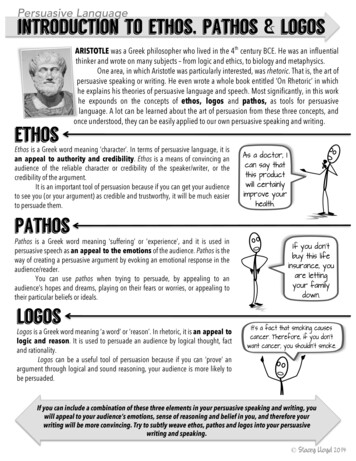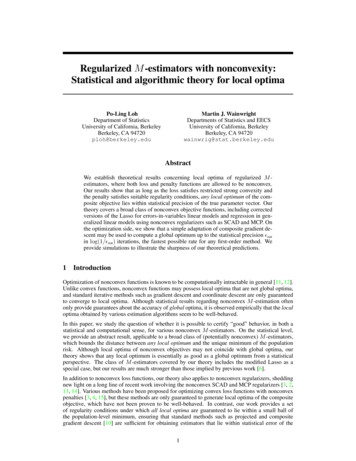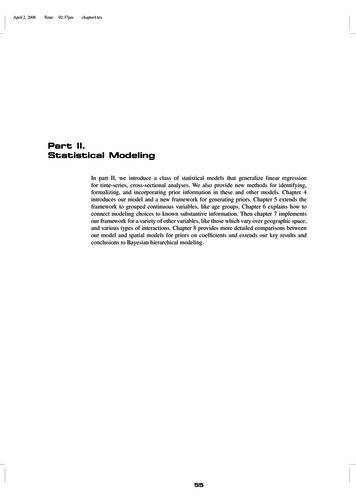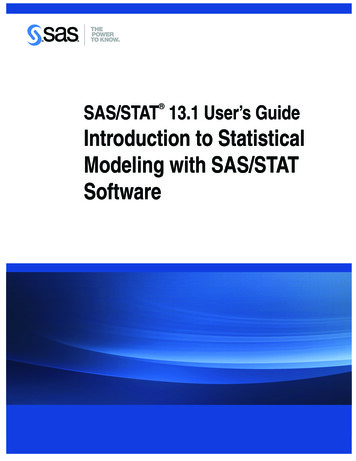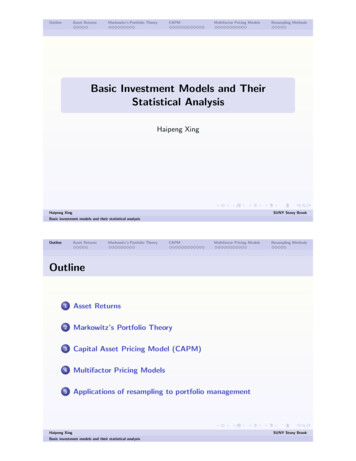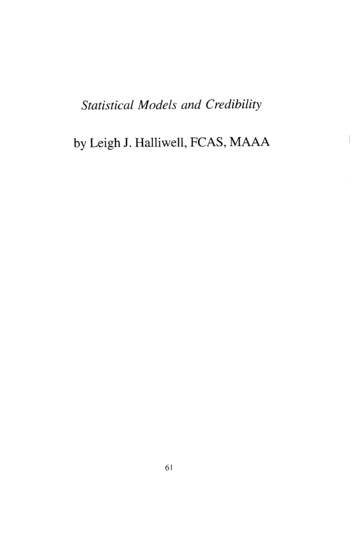
Transcription
Statistical Models and Credibilityby Leigh J. Halliwell, FCAS, MAAA
StatisticalModels and CredibilityLeigh J. Halliwell. FCAS. MAAAAbstractThe theory of credibility is a cornerstone of actuarial science. Actuaries commonly use it.and with some pride regard it as their own invention. something which surpassesstatisticaltheory and sets actuaries apart from statisticians. Nevertheless. the development ofstatistical models by statisticians and econometricians in the latter half of this century isvery relevant to credibility theory: it can ground as well as generalize much of the theory.particularly the branch thereof known as least-squares credibility. It is the purpose of thispaper to show how the theory and practice of credibility can benefit from statisticalmodeling.The first half of the paper consists of eleven sections. notes, references. and twenty exhibits.The technical content is subdued. and readers may content themselves with this half. Butthe technically inclined are invited to study the six appendices (A through F) of the secondhalf. Due to space limitations of the Call Paper Program. some of the appendices may bedeleted. If this should happen, the deleted appendices can be obtained by calling the authorat (201) 278-8860.The author is grateful to Kenneth Kasner, FCAS. MAAA. for his thoughtful and kindreview of the draft of this paper.Mr. Halliwell is a Fellow of the Casualty Actuarial Society and a member of the AmericanAcademy of Actuaries. In August 1997 he became a consultant at the New York office ofMilliman and Robertson. For two years prior to that he lived in Mexico City as theRegional Actuary of Latin America for the Zurich Insurance Group. And prior to that hewas the Chief Actuary of the Louisiana Workers’ Compensation Corporation, Baton Rouge.LA. His actuarial career began at the National Council on Compensation Insurance in BocaRaton. FL.62
I. IntroductionThroughout the twentieth century actuaries have been practicing something that they callcredibility.Although acknowledging some connections with statistics, especially withregard to Bayesian credibility, actuaries have tended to regard credibility as transcendingstatistics. This is illustrated in the historical sketch of the following section. But this paperwill proceed to show that advances in statistical modeling during the latter half of thiscentury legitimate and deepen typical uses of credibility.In order not to presume on thereaders’ knowledge of modem statistics, Sections 3, 4, and 5 will outline and illustrate thelinear statistical model. The treatment of credibility per SEwill begin in Section 6, wherewe will show how to introduce prior (or non-sample) information into the statistical model.It is hoped that the reader will be persuaded that to express credibility in statistical terms isnot only possible, but also advantageous. Six appendices at the end of the paper providemathematical foundations for much of what is glossed over in the sections.2. An Historical Perspective on CredibilityTo Matthew Rodermund was entrusted the formidable task of writing the introduction tothe textbook Foundations ofCasualtyActuarialScience. The task was formidable becauseit demanded a engaging history of the casualty actuarial profession and a distillation of itsessence. Rodetmund states, “It is the concept of credibility that has been the casualtyactuaries’ most important and most enduring contribution to casualty actuarial science.”63
[11:3].’After recounting the accomplishments of actuaries in experience rating,retrospective rating, merit rating, ratemaking, and reserving - all with an eye on credibility,he asks, “Readers who have come this far may conclude from what they’ve read thatcasualty actuarial science is the study and application of the theory of credibility, and that’sall. Is it all?’ [I 1:191 An affirmative answer is implied. And almost thirty years earlier L.H. Longley-Cook, although more reserved than Rodennund, prefaced his famousmonograph on credibility with the words “Credibility Theory is one of the cornerstones ofactuarial science . .” [9:3]The “Statement of Principles Regarding Property and Casualty Ratemaking,” adopted bythe Casualty Actuarial Society in 1988, defines credibility to be ‘&ameasureof the predictivevalue that an actuary attaches to a particular body of data.“’Actuaries often speakequivalently of the “weight” given to a body of data. The language of arraching or givingcredibility to data is suggestive of an important point made by Longley-Cook:the amount of credibility to be attached to a given body of data is not entirely an intrinsicproperty of the data. For example, there is always stated or implied in any measure ofcredibility the purpose to which data are to be used.Hence, we see that credibility is not a simple property of data which can be calculated bysome mathematical formula[9: 41If credibility is not entirely intrinsic to the data, then it is at least partially extrinsic.Inpractice, credibility is largely, if not entirely, extrinsic to the data. And what is extrinsic tothe data pertains to informed judgment; so it is fitting that Longley-Cook concluded hismonograph as follows:it is perhaps necessary to stress rhat credibility procedures are not a substitute for informedjudgment, but an aid thereto. Of necessity so many practical considerations must enter into’ In the ‘[n:p]’ format ‘n’ is the reference number and ‘p’ gives the page number(s).64
any actuarial work that the student cannot substitute the blind application of a credibilityformula for the careful consideration of all aspects of an actuarial problem. [9:25] (alsoquoted in [I I : 1Of.])Since the credibility of data is the predictive value or weight given to the data, the questionarises what to do when the actuary judges the data not to have enough predictive value orweight. The answer is to weight the answer which is based on the data with an answerbased on informed judgment; so it is natural for actuaries to speak of credibility-weightingthe empirical answer with another source of information.One great teacher and apologist of credibility was Arthur L. Bailey. Writing between 1945and 1950, he claimed that certain credibility procedures conflicted with current statisticaltheory; in fact, statistical training could hinder someone from accepting these procedures:The basis for these credibility formulas has been a profound mystery to most people who havecome in contact with them. The actuary finds them difiicult to explain and, in some cases,even difficult to understand. Paradoxical as it may be, the more contact a person has had withstatistical practices in other fields or the more training a person has had in the theory ofmathematical statistics, the more difftcult it has been to understand these credibilityprocedures or the validity of their application. [3:7]Bailey listed as three offending credibility procedures (1) theuseof prior hypotheses inestimation. (2) an estimation of groups together which is more accurate than estimatingeach group separately, and (3) estimating for an individual that belongs to a heterogeneouspopulation [4:59f.]. Speaking from his own experience and with the ardor of a convert. hewrote:I personally entered the casualty insurance field from the completely unassociated tield ofstatistical research in the banana business. The first year or so I spent proving to myself thatall of the fancy actuarial procedures of the casualty business were mathematically unsound.They are unsound, if one is bound to accept the restrictions implied or specifically placed onthe development of the classical statistical methods. Later on I realized that the hard-shelledunderwriters were recognizing certain facts of life neglected by the statistical theorists Now Iam convinced that casualty insurance statisticians are a step ahead of those in most fields.65
This is because there has been a truly epistemological review of the basic conditions of whichtheir statistics are measurements. I can only urge a similar review be made by statisticians inother fields. [4:6 I ]Bailey [3] sought to ground these procedures in what later became known as Bayesiananalysis. No doubt, in his day statistical theory could not accommodate certain actuarialideas. Therefore. he saw the actuarial profession as in “revolt,” as for example when hewrote:Philosophers have recently discussed the credibilities to be given to various elements ofknowledge. thus undermining the accepted philosophy of the statisticians.However, itappears to be only in the achwial field that there has been an organized revolt againstdiscarding all prior knowledge when an estimate is to be made using newly acquired data.[3:9f.)But a revolt involving Bayesian analysis was soon to happen among the statisticians. asAllen Maycrson remarked in 1964:Statistical theory has now caught up with the actuary’s problems. Stamng with the 1954book by Savage, and buttressed by the 1959 volume by Schlaifer and the 1961 book byRaiffa and Schlaifer. there has been. among probabilists and statisticians, an organizedrev011 against the classical approach and a trend toward the use of prior knowledge forstatistical inference.The relationship between Bayes’ theorem and credibihty was first noticed by ArthurBailey, who showed that the formula %4 /l-2)8 can be dewed from Bayes’ theoremIt seems appropriate, in view of the growing interest among statisticians in the Bay&anpoint of view. to anempt to contmue the work started 15 years ago by Bailey, and, usingmodem probability concepts, try to develop a throy of credibility which will bridge thegap that now separates the actuarial from the statistical world. [lO:BSf.lBayesian analysis has continued to be a popular basis of credibility theoryIt plays aprominent role in Gary Venter’s momentous chapter on credibility in the I;o rndurion.stextbook [ 131. But Bailey’s seminal idea was a “greatest accuracy credibility” (2:20]. ofwhich Venter writes:66
The most well developed approach to greatest accuracy credibility is lrasf squarescrrdihilrry, which seeks to mmimize the expected value of the square of the estimationerror . .More recent statistical theory. Bay&an analysis for example, also addresses the use ofdata to update previous estimates, and this will be introduced later below. Credibilitytheory shares with Bayesian analysis the outlook toward data as strictly a source to updateprior knowledge. Credibility, particularly least squares credibility is sometimes labeledBayesian or empirical Bayesian for this reason. It also gives thr same result as Bayesiananalysis in some circumstances, although credibility theory can be devrloped within thefrequentist view of probability . .Frequentist refers to an interpretation of probability as solely an expression of the relativefrequency of events, in contrast to a subjectivist view which regards probability as aquantification ofopinion. This latter view is a hallmark of Bayesian analysis. [13:384]This quotation clearly indicates that Bayesian analysis is not the be-all and end-all ofcredibility theory.Rather, despite some similarities. greatest accuracy credibility isindependent from Bayesian analysis, and especially from the on-going philosophical debatebetween the frequentists and the sub.jectivists. With all the limelight on Bayesian analysis,actuaries have not realized that statistical theory now has some non-Bayesian things to sayabout credibility.In particular, modem statistical modeling can accommodate the three“offending” credibility procedures mentioned above; moreover, it provides a richer world ofideas than the one-dimensional formula ,UT I-Z)B.3. An Overview of the Linear Statistical ModelIn an earlier paper [7] the author treated the best linear unbiased estimation (BLUE) of thelinear statistical model. That treatment was detailed and self-contained; so the author willassume it, rather than derive it. In Appendix C of that paper the author compared BLUEwith Gary Venter’s formulation of least-squarescredibility [ 13:418], and concluded:Thus Venter is essentially doing best linear unbiased estimation on a linear model. Theauthor hopes that actuaries will begin to see the subject of credibility from the perspectiveof statistical modeling. [7:335]67
It is for the purpose of realizing that hope that the present paper is written.The form of a linear’ statistical model is y Xp e, where Var[e] Z 0’0.In thismodel y and e are (PI) vectors. X is a (txk) matrix, j3 is a (kxl) vector, and C and 4, are(fxr) matrices. The design matrix X is known. or posited; y is observed. Although theparameter vector p is not known, it is not random; an estimator of p is random, but p itselfis not. What injects randomness into the vector y is the error term e. e is not observable:however, E[e] Oc,,r,,and Var[e] is known, or posited, at least to within a proportionalityconstant, i.e., Var[e] oc@ No assumption is made as to the probability distribution of e.Most presentations of the linear statistical model dwell on how to estimate p, but there is awider approach. Suppose that the I rows of the y are of two types, those which have beenobserved and those which have not. The observed portion of y we will call yr and say thatit is (11xI); the unobserved will be y2 and (rrx I j. Of course, I, 12 I. We can also arrangethe rows of the model so that the observed portion comes first. Similarly partition X and e.so that the model looks like:Y, X,D e,, whereVar[:j] Z;[ : ::1-02* 02[ ::l]y2 X,P e,Since variance matrices are symmetric (cf. [7:304] and [8:43]). 121 CIZ’and 021 @I:‘.Being unobserved, yr contains missing values. The problem is to formulate an estimator ofy2 based on yt, X, and Z. In particular, we want the estimator to be linear in yt, to be68
unbiased, and to be in some way best; i.e., we want the best linear unbiased estimator(BLUE) of yz. In Appendix C of the earlier paper [7] it is shown that the BLIJE ofyz is:3, x,P &,G(Y,- x,ibVar[y, -9: ] ZZ2- C,,C;,‘C,, (X1 - Z,,C;,rX,)Var[fi](X2i (X:C;:X,)- Z,,.&‘X,)‘,where‘X;X;,‘y, andVar[b] (x;x,;x,,-’This is equivalent to: 2 x,/3 a,qI;‘(y,Var[y2 - ,I - X,P!02(Q2 -U%,O, ‘CP,,) (X, -02,0,;‘X,)Var[ ](XLb Var[b] 02(x;q x,)-’If oz is not known, it can be unbiasedly estimated as 6’ Ut,-k'where 6, y, - X,b[7:333f.]What does it mean for ji2 to be best? As explained in Appendix A. of two competing linearunbiased estimators the best estimator is the one the variance of whose prediction error issmaller:This means that the right-hand side of the second inequality is a non-negative definitematrix. The estimator with the caret is at least as good as the one with the tilde; and if theexpression is non-zero, it is better69
Before applying this overview to credibility. the next two sections will warm the reader upwith two simple linear models. Prior to riding a horse it is wise to practice on ponies.4. The Simplest Statistical Model (Example I)Suppose that we have seven non-covarying and identically distributed observations of arandom variable: 6.164. 11.103. 9.663, 12.998. 10.329. 9.564. and 9.602. A simple modelof the i* observation (i I. 7) is y, fi e,. where Var[e,] c?. The matrixformulation is:6.164I I.1039.66311.998 y xp e IO.3299.5649.602III1 B e1I‘JSince the observations are non-covaqing and identically distributed. Var[e] 0’1,. In thisC’*.v,simple example rj (X’X).’ (X’y) Cl ’ - y - 9.917. So the parameter is the mean ofthe observations. and the estimator of 0’ is the sample variance ( 4.240). One might reactthat this is like using a sledgehammer to crack a walnut: “Why go IO all this trouble whenthe mean and the variance are the obvious solutions from the start?” The answer, however,deserves to be pondered: This model. the simplest of all. undergirds the mean and variancefunctions; these functions are in reality pre-packaged solutions of the simplest linearmodel.70
Exhibits I and 2 present and solve this model. The seven observations are contained in YI.Since these observations are non-covatying, the off-diagonal elements of @,Ir are zero; sincethey are identically distributed. the diagonal elements of Qtt are equal (ones).Thus.according to the formulas of the previous section (which are repeated in the exhibits). p andits variance may be estimated.However. in this example we have chosen to estimate. or to predict, a certain (1 I xl) vectoryz X er. What y2 estimates is determined by XI, (&t, and @2. The first sevenelements of y2 have the same variance as el and are perfectly correlated with er. Thismeans that as far as this statistical model is concerned, these seven elements areindiscernible from et, and hence nre et. The eighth element of yz models the constant 0.The ninth element models a new error term, i.e., an error term which has the same varianceas el but does not covary with et. The last two elements of y2 model 0 without an errorterm and with a new error term. Exhibit 2 derives the estimate of y2 and the variance of itsprediction error.5. Another Simple Statistical Model (Example 2)Exhibits 3 and 4 concern a slightly less simple example. We have actual utility expensesfor thirteen months (Sep95-Sep96). For each of these months there is a suitable utilityindex. We desire to estimate the expenses for the next three months (Oct96-Dec96), andare comfortable with 160, 162, and 168 as predictions of the utility index.71
Many actuaries would simply rescale the last month’s expenses. For example, Oct96expenses are expected to be 2,192*(160/156.779) 2,237. But this ignores the informationfrom the earlier months. If one were to do a similar calculation for the other twelve months.one would then have thirteen estimates in need of combination. If this combination wereperformed correctly, one would be doing a statistical model in a roundabout manner.Exhibit 4 tackles the problem directly. The observed expenses are equal to !3 times theutility index plus a error term.However, 011 is not of constant variance. It seemsreasonable for the standard deviation of expenses to be proportional to the utility index(e.g., if prices were to double, the expense swings would double). This causesthe variancesof the expenses to be proportional to the squares of the utility indices. which squares arefound along the diagonals of @,I and 011. Each month’s error is assumed not to covarywith the other months’ errors. In this exhibit I3and yz are estimated in accordance with theformulas already mentioned. One can also take linear combinations of yz and of thevariance of its prediction error. For example [lI l]i2 [I2,3391 I] 2,368 [7.163] isI 2,456 1the estimated expense for the entire fourth quarter. Moreover, the variance of its prediction11iI1r40672 2941 30502941 41695 3089 1 [145370], for a3050 3089 44841 1standard deviation of 38 I.72
6. A Simple Example of a Model wirh Prior Information (Example 3)Now that we have warmed up on two simple models, let us see how to express credibility ina statistical model. We return again to the seven observations of Ecxample I (Exhibit I ).The numbers 6.164,, 9.602 were actually generated as random numbers with mean IOand variance 4. Therefore. the mean and variance estimates of 9.917 and 4.240 are close.Of course, if one knew the true parameters, they would not need to be estimated.But suppose that prior to observation we believed (for w,hatever reason) that the mean is 11and the variance is 3. Could we benefit from combining observation with our prior belief?(We will assume that the prior belief is well-founded, so that it is prior information. ratherthan prior misinformation.) The answer is “Yes;” it is possible, even advisable, to combineprior information with observation.One way of combining is Bayesian inference (Appendix B). But a simpler way is to treatthe prior information as if it had been observed. Therefore, in Exhibit 5 the priorinformation is appended to the observations as an eighth row (separated from the genuineobservations by a light line). In an earlier paper the author referred to prior information asquasi-observation [‘l:Section 6 and Appendix E]. Judge [8] refers to observation as sampleinformation and to prior information as non-sample information. Combining the two iscalled mixed estimation [8:877]. Our formulation of this hybrid model, which differs onl)slightly from Judge’s, is:73
So the best linear unbiased estimator of D is: (XZ’X R’V-‘R)-‘(X’C-‘y R’V.‘r)Certain properties of this estimator are explored in Appendices A and B. In particular. theestimator is a matrix-weighted average of more familiar estimators and has a smallervariance. These properties depend on the block diagonality of the hybrid variance matrix.i.e. that e and v do not covary This is a natural assumption; however, the estimator canaccommodate covariancc if these properties are surrendered.Exhibit 5 works out the mixed estimate of p as 10.099. This is equivalent to what actuarieswould call a weighted-average of the data with the prior hypothesis. where the weight of thedata, 0.832. results from the well-known nl(n k) formula.It is interesting. perhapssurprising, that the variance of the mised estimator. 0.904. is less than both the \.ariancefrom the unmixed model (4.240) and the variance of the prior hypothesis (3.000). Thissynergy of combination is analyzed in Appendix A.74
One complicating detail of this model has to do with the variance matrix. Usually wespecify the variance matrix not absolutely,but relatively,or to within a proportionalityconstant. In other words, in the model y Xp e, where Var[e] C 020, the estimator ofp is invariant to the scale of C. So we usually specify Q,. calculate the estimator of p, andthen derive an estimate of 02, In the unusual event that V/c? is known [or, V is known towithin the same proportionality constant to within which C is known), then one can use themixed estimator with the relative hybrid variance matrix. However. the usual case is that Vis known absolutely and Z is known relatively. In this case the author recommends that o2be estimated in the unmixed model, and that the absolute matrix6%[ 1Vbe used in themixed model. (This implies that one should solve the unmixed model as a prelude tosolving the mixed.) This was done in Exhibit 5, where the 4.240 down the diagonal of Qttis the estimate of the o2 of Example I Using an estimate of the absolute variance for theabsolute variance itself disturbs the optimality (the “bestness” of “best linear unbiased”) ofthe estimator; however. statisticians and econometricians feel that this is a small price topay for the benefit derived from combining observation with prior information. Moreover,the estimate of o2 in the mixed model (0.904 in Exhibit 5) will not significantly differ from1 if the absolute variance matrix is correct, Therefore. one can assume the estimator of c?in the mixed model to be a chi-square random variable with #degrees of freedom dividedby #(i.e.,a gamma random variable with mean I and variance 2/dfl and can perform asignificance test. But seldom is there a problem. and this will not be mentioned again in thefollowing examples.75
7. A Statistical Model of Merit Rating (Example 4)A simple method of merit rating a driver is to make the premium proportional to theexpected number of accidents. This ignores differences of severity, e.g., driver A is half aslikely to have an accident as driver B, but perhaps his accidents are likely to be twice assevere. However, as with experience rating in workers’ compensation, it is natural tosuppose that the insured has more control over whether an accident will happen than overhow severe it will be. So we wish to estimate a driver’s accident frequency, and theproblem is to determine how much a driver’s accident record should differentiate him fromhis peers.Lester Dropkin paved the way for a Bayesian solution, viz., that every driver has his ownaccident frequency m, and that the number of his claims is Poisson distributed with mean m.s Moreover, the frequencies of the driversTherefore, the probability of x claims is me-,X!of a certain class are gamma-distributed with parameters P and u [5:392f.].So the-Ummrm’,and the ms are distributed withprobability density function of the ms ismean r/u and variance r/a2. As Dropkin showed [5:399]. the claim count distribution of adriver randomly selected from the class is negative binomial with mean r/u and variancera laa76
But the posterior density of a driver’s one-period m given x, . I,, accidents in n previousperiods is proportional or equal to:This posterior density is gamma with parameters r’ r i-11, and u’ 0 n.Theposterior mean, to which the merit-rated premium should be proportional, is a weightedaverage of the prior mean (r/a) and the empirical mean (cf. also [10:99-l 0 1] ):I-’ r-r.,o1u nThe same result is obtained from the following linear model:77
Each X, is explained as some mean value p plus an error, where the error is like a Poissonrandom variable (with parameter t-la) centered about zero. But the last row is a quasiobservation: it is as if !3 had been observed as r/u but obfuscated with an error whosevariance is rla2. The mixed estimator is:Irj 1jIFY x, .CL'r/a;0U. - x,r0',.000r/a00\IIr/a2r/a0' 0 .or/u0001 f-’f . ‘ Urr I, . ,. x, r1 . 1 a0 :;:-' I;;r a,The statistical model reachesthe same conclusion without assuming a distributional form.Exhibit 6 shous another example of merit rating. A driver had one accident in the secondof three periods (years). The variance of his yearly accidents is assumed to be 0.0625(standard deviation of 0.25). But there is prior information that drivers of this class areexpected to have 0.25 claims per period with a variance of 0.0225 (standard deviation of0.15). In Part A of the exhibit the three years are three one-year observations. But in Part Bthey are summarized into one three-year observation. The estimates are the same in both78
parts, but their variances differ. This hints that summarization is attended withlossofinformation about prediction error variance. An amount of 1 over three years could meanl/3 each year and no apparent variance. Or it could mean widely varying positive andnegative amounts by year and an arbitrarily large variance. If actuaries \vish to speak ofvariances, then they should know where to stop summarizing the data.8. Stochastic and Exact Constraints (Example 5)The prior information. or the quasi-observation, r RP v is a stochastic constraint since vdoes not have to be zero. However, as V Var[v] approaches a zero matrix, the constraintbehaves more and more like the exact constraint r RD. In an earlier paper [6:26] theauthor filled out a loss triangle by means of estimated pure premiums by payout year. Butthe pure premiums by year were exactly constrained so that the sum of the first seven ofthem (the pure premium of payments before 84 months) was 7.213. Exhibit 7 shows thatthe same result is obtained by adding a quasi-observation that this sum is 7.213 with a errorwhose variance is IO-” relative to the variances of the observations.’ Exhibit 8 shows howdifferent the estimate is when the constraint is relaxed. (One should not suppose that theestimates of a2 in the two exhibits are equal; they differ by about six million.) Appendix Cproves that the mixed model (stochastically constrained model) approaches the (nonstochastically) constrained model as V approaches zero.79
9. Credibility and Random Effects (Example 6)So far. credibilityhas been statistically modeled by adding quasi-observations toobservations. i.e., by mixing non-sample with sample information.The non-sampleinformation is aptly considered to be logically prior to, if not also temporally prior to, thesample information. It too may have been derived from a sample; but if so, its sample is adifferent sample. If the two samples are grouped into a grand statistical model, such as thefirst grand model of Appendix A,the submodels are naturally considered as non-simultaneous. or temporally extensive or longitudinal.For esample. if we begin observingthe pure premium of State X with the prior opinion that it is 0.10 with a standard deviationof 0.02, we opine thus because in the past we have observed the pure premiums of similarStates A, B,But credibility may also involve the simultaneous modeling of similar entities. Each entityhas its own model, and the models are grouped into a grand model; however. the(sub)models are simultaneous, or temporallyintensive or latitl dinul.Example 6, whichbegins with Exhibit 9, will illustrate this concept. This example, taken from Venter[ 13:433], consists of six observations of a pure premium from each of nine states. If thepure premiums were unrelated, then one could do no better than to solve nine independentmodels (to take nine averages). If the pure premiums had to be equal, then one could do nobetter than to average the fifty-four observations. But an actuary would rightly feel that thetruth lies in between these two extremes: the pure premiums of the states are neitherunrelated nor identical. The pure premium of one state is related with those of the other80
states, but it also has some identity of its own. A natural way of expressing this is toassume that the pure premiums deviate randomly from a common value, e.g., B, PCJf v,.PO is the (fixed) effect common to all the states, and v, is the (random) effect whichdifferentiates State i from the other states. Each v, is distributed with mean zero and some(known or unknown) variance V. and the v,s do not covary one with another. It is thisassumption of being distributed that makes the effect random.For the moment we will abstract from the example. In general we have n models: each ofthe form y, X , e,, where Var[e,] Z, and the e,sdo not covary. At this point we have nindependent models. B
Statistical Models and Credibility Leigh J. Halliwell. FCAS. MAAA Abstract The theory of credibility is a cornerstone of actuarial science. Actuaries commonly use it. and with some pride regard it as their own invention. something which surpasses statistical theory a


